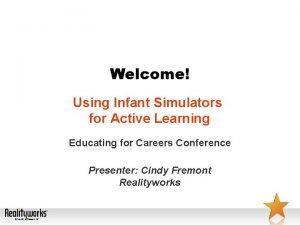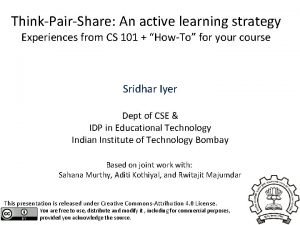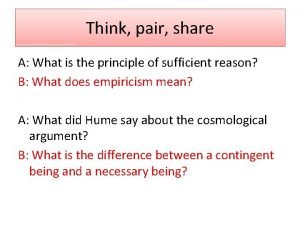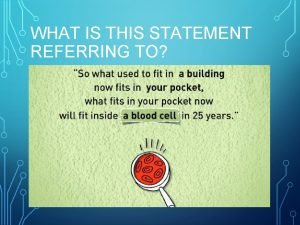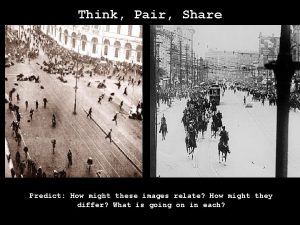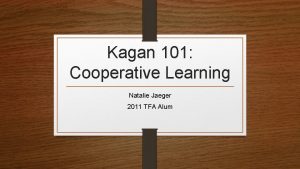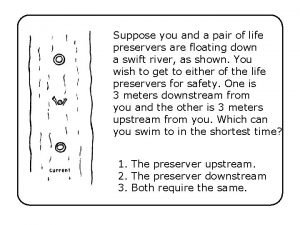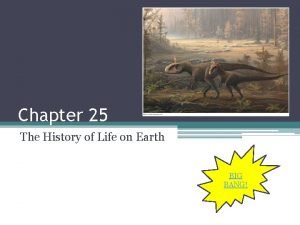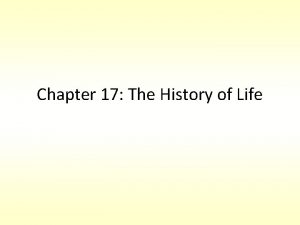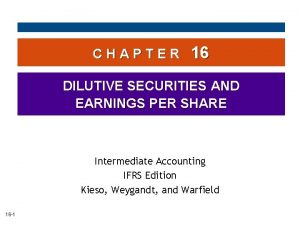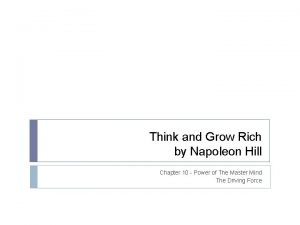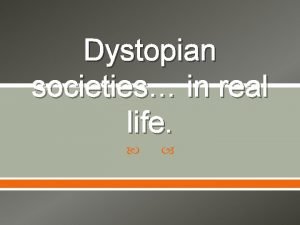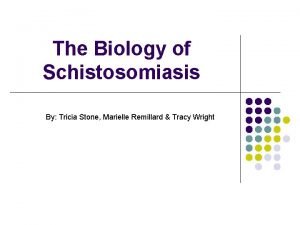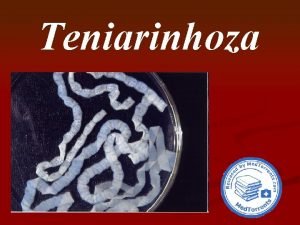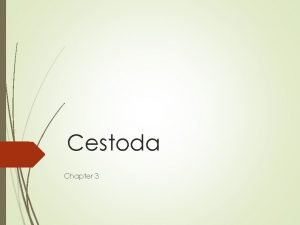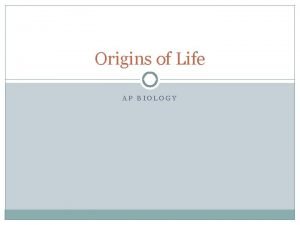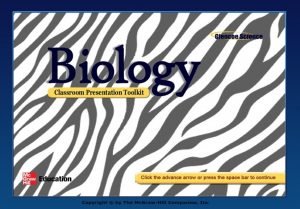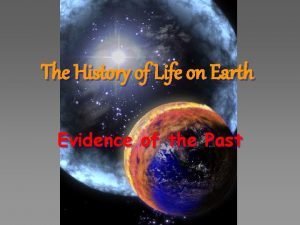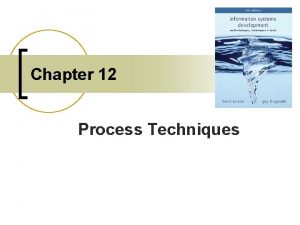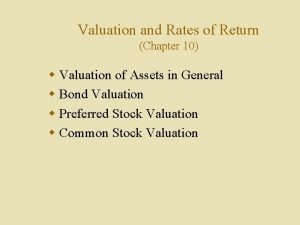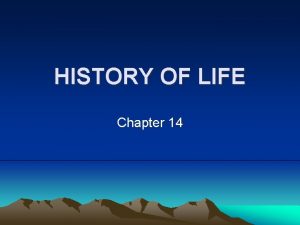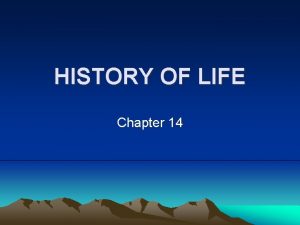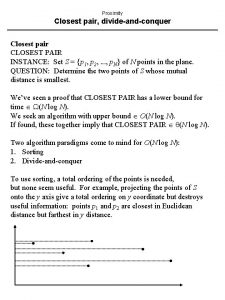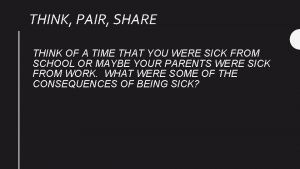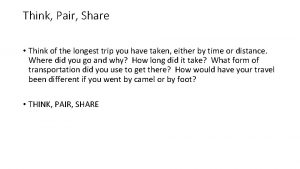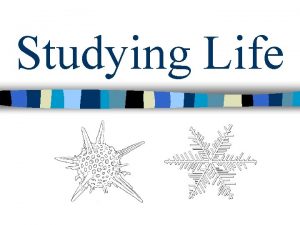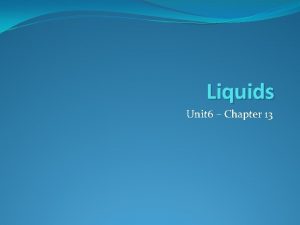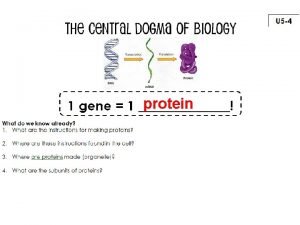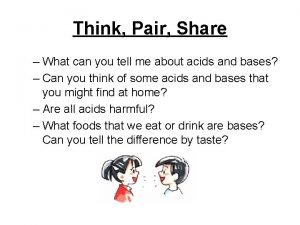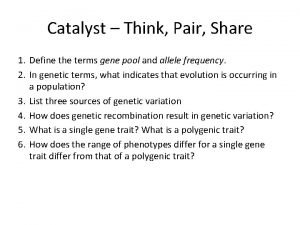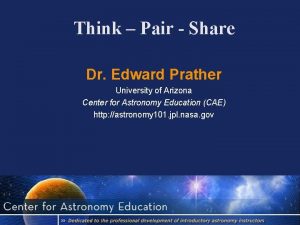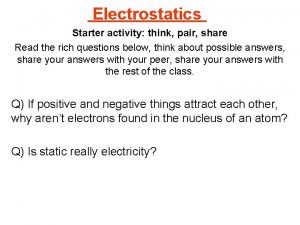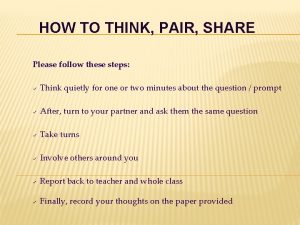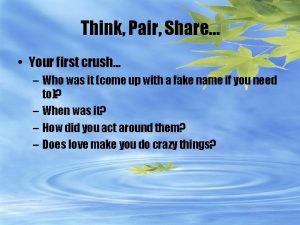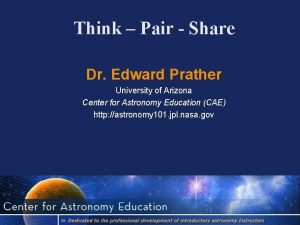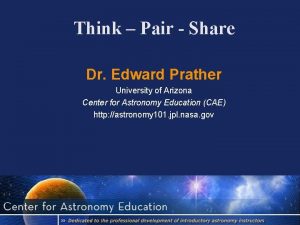HISTORY OF LIFE Chapter 14 Think Pair Share





















































- Slides: 53

HISTORY OF LIFE Chapter 14

Think, Pair, Share 1. How old do you think the planet Earth is? Explain. 2. What physical changes have occurred on Earth during its history? What caused these changes? 3. What is a Mass Extinction? What evidence do scientists have?

The Record of Life Ch. 14 - Section 1 - pg. 369

Early History of Earth • 5 billion years ago our solar system was formed as a swirling mass of gas and dust • Gravity pulled this material together to form the sun • Remaining gas and debris circled the newly formed sun • Collisions between the space debris created the planets

• Earth formed about 4. 6 billion years ago, dated by studying the layers of rock that make up the planet • Young Earth was hot, there was no atmosphere to block UV rays from the sun • No oxygen to breath • A lot of carbon dioxide and water

• Life originated in Earth’s oceans 3. 93. 4 billion years ago • Early life forms would have been very similar to bacteria

Think, Pair, Share Table 14. 1 pg. 370 4. Which of the following fossil types have you seen before? Explain when and where. Read Paleontologists – Detectives to the past on pgs. 370 – 371. 5. Give 2 examples of evidence paleontologists can use to determine information about the past. EXPLAIN!!!

History in Rocks • Rocks provide information about Earth’s history including the history of life on Earth • Paleontologists study ancient life and fossils

Figure 14. 2 pg. 372 • Fossils are found in sedimentary rock • Organism gets buried in mud, sand, or clay after they die • More sediment gets layered over the organism, over time the minerals in the sediment replace the minerals in the skeleton


Think, Pair, Share Figure 14. 3 pg. 373 6. What are the chances that the Protoceratops death was not an accident? Explain your reasoning. 7. What are 2 ways that the fossil in the Figure 14. 3 could have become exposed?

Dating Fossils • Relative Dating (stratigraphy) = layers of rocks have different ages, the “youngest” layers on top; older fossils found in older layers of rock, ex. stacks of newspapers. • Radiometric Dating = atoms in the fossil break down at a certain rate, age of the fossil depends on the ratio of atoms to broken down atoms.

Geologic Timescale Fig. 14. 4 pgs. 374 & 375 • Begins with the formation of Earth and goes through present time • Scale is divided up by the kinds of organisms that lived during that time

• Layers of rock match up with the Geological Timescale

Think, Pair, Share Organization of the G. T. S. 8. List each Era from oldest to most recent and describe the types of organism found in each one. • Broken down into 4 Eras, each era is further broken down into Periods. • The eras and periods are characterized by specific events and specific organisms • Mass Extinction = many organisms disappear from the GTS almost all at once

4 Eras 1. Precambrian Era • Beginning of the GTS, longest era, 87% of Earth’s history • Oldest rocks and fossils are from the Precambrian Era • First organisms were single celled

2. Paleozoic Era • Cambrian Explosion occurred • Enormous increase in diversity of life in oceans • Organisms with backbones emerged • Mass extinction occurred at the end of the Paleozoic Era killing off 90% marine life, 70% land life

3. Mesozoic Era • began 248 million years ago • Dinosaurs died out during another mass extinction making room for mammals • Meteor crash most likely caused the mass extinction

4. Cenozoic Era • Began 65 million years ago • Increased diversity in mammalian life • Modern humans appeared 200, 000 years ago

• As you move towards the bottom of the rock layers, you move back on the Geological Timescale • Similar fossils found on different continents because at several times in Earth’s history the continents were connected

Thorium decays into lead. It takes 75, 000 years for half the amount of thorium in a sample to decay into lead. Half Life Total years passed Grams of Thorium Grams of Lead 0 0 15 0 1 75, 000 2 3 4


• Pangea existed 250 million years ago • Plate Tectonics = the surface of Earth is made up of plates that drift on top of a molten layer of rock • http: //www. nature. nps. gov/geology/usgsnps/ animate/PLATES_3. MPG • http: //www. ucmp. berk eley. edu/geology/teca ll 1_4. mov


The Origin of Life Ch. 14, Sec. 2

Spontaneous Generation • Pre-17 th century it was believed that living things arose from nonliving things through a process called Spontaneous Generation

• 6 th century BC: Greek philosophers propose life arose when sunlight was shined onto mud. Why?

• 1600’s: It was believed that mice appeared from rotten grain. Why?

Francesco Redi (1626 -1697) • Mid-17 th century people believed flies were spontaneously generated from rotting meat • Redi was a scientist who noticed a life stage to the flies on the rotten meat – 1. Maggots – 2. Pupa – 3. Flies • He observed that the maggots appeared where flies had landed first


• Redi predicted that if the meat could be kept away from the flies, then there would be no maggots on the meat • He did not believe that flies spontaneously generated from meat!!! • So he set up his experiment…

• Control Group = uncovered jar of meat, flies layed eggs, which hatched into maggots, which turned into more flies • Experimental Group = covered jars of meat, flies have no chance to lay eggs, new flies do not appear

Louis Pasteur (1822 -1895) • Finally disproved spontaneous generation once and for all! 200 years after Redi’s experiment • Pasteur set up an experiment where boiled broth was exposed to air, but microorganisms couldn’t fall in

• By the 1800’s scientists understood (thanks to the microscope invented a century ago) that microorganisms (bacteria & viruses) caused people to get sick • But….

• Some scientists still believed that bacteria and viruses spontaneously generated from the air • Pasteur proved them wrong with his experiment

• Boiled broth was exposed to air in a specially shaped flask over a period of time but nothing grew • Once the neck was broken off bacteria grew in the broth • Bacteria did not spontaneously grow from the air!!!

• Thanks to Pasteur…. • Biogenesis = living organisms come from other living organisms

Modern Experiments on Origins • All elements found in organic compounds needed to form biomolecules existed on Earth since its formation • Early atmosphere contained Ammonia (NH 3), Hydrogen Gas (H 2), Water Vapor (H 2 O), Methane (CH 4)

• Under high temperature the gases might have formed simple organic compounds (contains Carbon) like amino acids • When Earth began to cool the organic compounds would have condensed with the water vapor and collected in lakes and seas

Stanley Miller & Harold Urey (1953) • Recreated the conditions of early Earth in the lab on a smaller scale • Included chemicals present at the time and an energy source similar to what as present at the time • Able to generate amino acids (biomolecule)

https: //www. youtube. com/watch? v=NNijmxs. KGbc

Alternative Hypotheses • 1. Life (biomolecules) emerged in ice (Stanley Miller) • Within ice there are chemicals to create biomolecules & microscopic pockets of water

• Water freezes forcing the chemicals to be close together which increases the chances of chemical reactions occurring • When the ice melts the biomolecules generated are released into oceans

• 2. Life (biomolecules) emerged in deep sea vents • Vents provide the heat & chemicals that could cause chemical reactions to generate biomolecules

Formation of Protocells • Protocell = Heating the amino acids can cause them to take on some life activities like growth and division

First True Cells • No direct evidence of the first cells, scientist can only analyze data that we collect now • Early Earth had little oxygen, oldest fossils thought to be cells resemble the size & shape of some living prokaryotes, the first cells had organic molecules to eat

• Therefore…. • The first cells were anaerobic, heterotrophic prokaryotes • Anaerobic = respiration that doesn’t require oxygen • Heterotrophic = needs to eat other things in order to get the organic molecules needed for life

• Next evolved… • Autotrophs = make their own food • Early autotrophs similar to present day Archaebacteria • Archaea = prokaryote organisms that thrive under harsh conditions, make food through chemosynthesis • Chemosynthesis = CO 2 is the carbon source, energy comes from the use of inorganic chemicals


• Next evolved… • Photosynthetic prokaryotes • Autotrophs now able to use sunlight energy to make food • Created oxygen for the atmosphere which allowed for an increase in diversity of life because now there was an ozone layer (provides protection from UV light)

Endosymbiotic Theory pg. 385 figure 14. 15 • Lynn Margulis – hypothesis based on experiments and observations • Proposes that eukaryotes evolved through a symbiotic relationship of prokaryotes. • Ancient prokaryotes engulfed other prokaryotes and instead of digesting them they survived together. • Evidence – 1. chloroplasts and mitochondria contain DNA and ribosomes that are similar to the DNA and ribosomes in prokaryotes and unlike DNA in eukaryotic cells. 2. Chloroplasts and mitochondria reproduce independently of cells that contain them.

• This explains why mitochondria has its own DNA

Endosymbiosis • Endosymbiosishttp: //highered. mcgrawhill. com/sites/9834092339/student_view 0/ chapter 4/animation_-_endosymbiosis. html
 Cone of learning
Cone of learning Think pair share kagan
Think pair share kagan Pair and share activity
Pair and share activity Study jams seasons
Study jams seasons Think pair share poster
Think pair share poster Think pair share cooperative learning
Think pair share cooperative learning What are think-pair-share debates?
What are think-pair-share debates? Share and discuss
Share and discuss Think-pair-share advantages and disadvantages
Think-pair-share advantages and disadvantages Darlene redmond
Darlene redmond Think pair and share page 119-120
Think pair and share page 119-120 Think pair share
Think pair share Think pair and share images
Think pair and share images Dhirubhaism
Dhirubhaism Stand up hand up pair up questions
Stand up hand up pair up questions Mix pair share kagan
Mix pair share kagan Ordered pair and unordered pair
Ordered pair and unordered pair Rolling pair is higher pair
Rolling pair is higher pair Think pair chair
Think pair chair Robin and jay poem
Robin and jay poem Think fam think
Think fam think Invested 10000 in wipro in 1980
Invested 10000 in wipro in 1980 Suppose you and a pair of life preservers
Suppose you and a pair of life preservers Chapter 25 the history of life on earth
Chapter 25 the history of life on earth Chapter 17 the history of life
Chapter 17 the history of life Basic and diluted eps
Basic and diluted eps Win win attitude
Win win attitude How do we use critical thinking in everyday life
How do we use critical thinking in everyday life Also history physical
Also history physical Think and grow rich chapter 10
Think and grow rich chapter 10 Last sermon of prophet
Last sermon of prophet Lec hardver
Lec hardver Is north korea a dystopian society
Is north korea a dystopian society Schistosoma life cycle stages
Schistosoma life cycle stages Life history of taenia solium
Life history of taenia solium Equilibrial life history
Equilibrial life history Metagonimus yokogawai
Metagonimus yokogawai Iteration control structures
Iteration control structures History of life on earth
History of life on earth Life history
Life history The history of life section 1 fossil evidence of change
The history of life section 1 fossil evidence of change Tuzo wilson
Tuzo wilson About gandhi in english
About gandhi in english Realistic fiction subgenres
Realistic fiction subgenres Entity life history
Entity life history Intrinsic value per share formula
Intrinsic value per share formula Titan oil recovery share price
Titan oil recovery share price Fundamental indicators
Fundamental indicators Sharing
Sharing Wipro share price in 1980
Wipro share price in 1980 Alteration of capital
Alteration of capital Safety share ideas
Safety share ideas Intermediate accounting chapter 15
Intermediate accounting chapter 15 Markedsfølger strategi
Markedsfølger strategi
